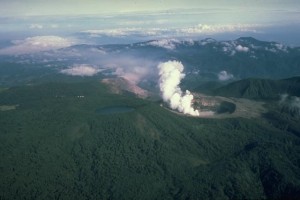Thanks to the Arenal Volcano’s geothermal activity, there is a number of natural hot springs throughout the La Fortuna region. The water issuing from a hot spring is heated by its contact with hot rocks or magma from the volcano.
Catarata de La Paz
La Paz is the last of a series of five waterfalls along the La Paz River, and part of the La Paz Waterfall Gardens.
Parque Nacional Volcán Poás
The Poás Volcano sits at 8,882 feet above sea level, in the province of Alajuela, 40 miles north of San Jose. It is one of the most active volcanoes in Costa Rica, with the last eruption reported earlier this year (late March 2014). There are two summit crater lakes: Lake Botos is cold and clear, and last erupted about 7500 years ago. Laguna Caliente, on the other hand, has been very active, is geothermally heated, and is among the world’s most acidic natural lakes, with a pH of near zero. The first historical eruption was reported in 1828.
INBIOparque
The National Institute of Biodiversity (INBio) was established in 1989 and is a private, public interest, non-profit association, whose mission is to promote a greater awareness of the value of biodiversity. During our tour of the park we watched a video presentation and walked through trails representing different types of Costa Rican forests: Rainforest, Pre-Mountainous Forest, Wetlands and Dry Forest.
Exploring downtown San Jose …
add photos
San Jose, Costa Rica
The Costa Rican capital is the largest city in the country, with a population of about 1.5 million in the metropolitan area. The city is located in the Central Valley region, an elevated plateau (3,839 feet high) surrounded by mountains of the Central Range in the north and those from the Talamanca Range in the south. The high elevation, the mild climate (59°F-86°F) and the volcanic soil makes it the ideal place for growing coffee!





